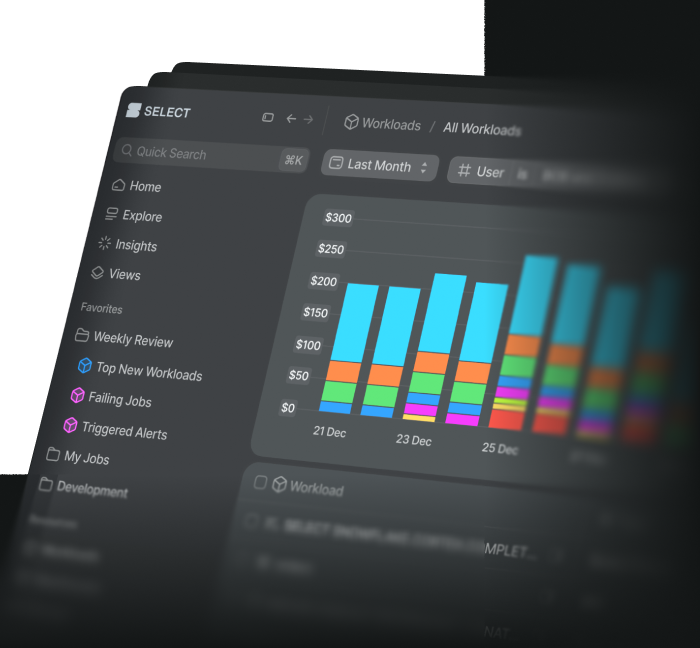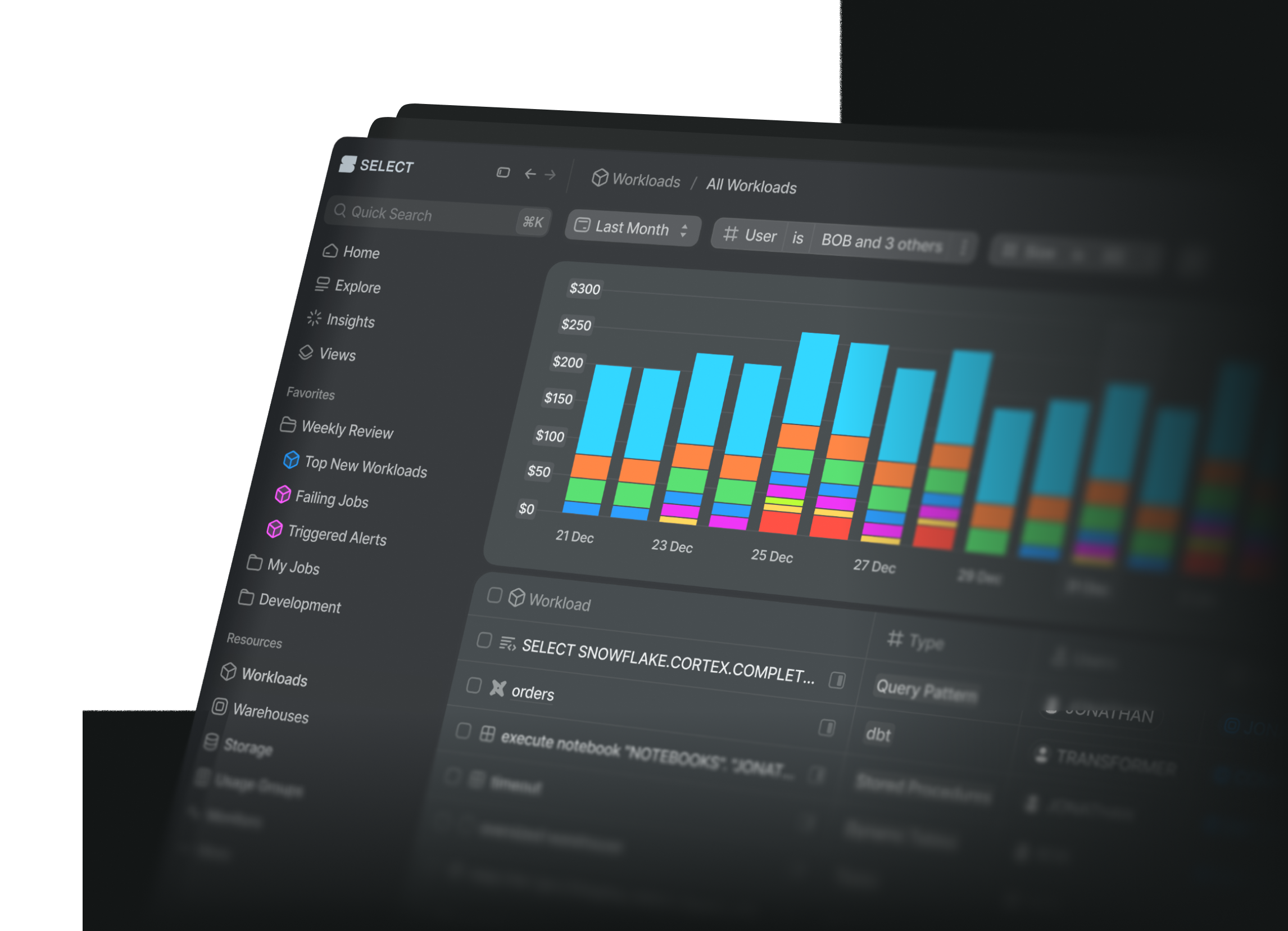
Monitoring Snowflake AI Costs: The Complete Series
Jeff SkoldbergMonday, October 20, 2025
Slides from the webinar above can be found here.
---
Snowflake has an impressive set of AI features. You can run language models directly in SQL, build semantic search into your applications, extract data from documents, and let business users query data in natural language. The problem is, each of these services has its own pricing model, its own monitoring views, and its own ways to accidentally rack up costs.
I've spent the last few weeks deep in Snowflake's AI offerings, and I've written this series to help you avoid the surprises I've seen happen to our customers. Traditional Snowflake cost management focuses on warehouse sizing and query optimization. AI services require a completely different mental model: token counts, message-based pricing, serving compute, embedding costs, and various combinations.
This series covers every major Snowflake AI service with practical SQL queries, real pricing examples, and opinionated recommendations. Below is a quick summary of the entire series; each section contains a link to the full article on the topic. You can use this article as your Table of Contents for further exploration.
Snowflake Cortex Search: Overview and Cost Monitoring
Cortex Search is a fully managed hybrid search service that handles vector, keyword, and semantic search for RAG applications. The cost structure is the most complex of all Snowflake AI services: you pay for serving compute (ongoing cost per GB of indexed data), embedding tokens during indexing, warehouse compute for refreshes, storage for indexes, and cloud services overhead. This guide breaks down each component with specific SQL queries to track daily and hourly consumption, plus recommendations on using primary keys for incremental updates and right-sizing your search services before costs spiral.
More details on usage, understanding and monitoring costs can be found in our full blog post on this topic.
Snowflake Cortex Analyst Costs: Overview and Cost Monitoring
Cortex Analyst converts natural language questions into SQL queries, and it uses message-based pricing rather than token-based pricing. Every successful query (HTTP 200 response) costs you one message, regardless of complexity, but you also need to account for the warehouse costs of actually running the generated SQL. The full article explains how to use the CORTEX_ANALYST_USAGE_HISTORY view to track message consumption by user and time period, and provides strategies for attributing warehouse costs when Cortex Analyst shares compute resources with other workloads.
Check our full blog post on this topic to learn more about using Cortex Analyst, how it is billed, and how to monitor costs.
How to Monitor Cortex AISQL Function Costs in Snowflake
AISQL Functions like AI_COMPLETE, AI_EXTRACT, AI_CLASSIFY, and AI_SUMMARIZE let you run AI models directly in SQL queries. These functions use token-based pricing where both input and output tokens count for generative functions, and costs vary dramatically by model choice (premium models can cost 10x more than smaller alternatives). This article provides real pricing examples showing that analyzing 10,000 product reviews costs $0.96 with GPT-4o-mini but $9.00 with Llama 3.1 405B, complete with SQL queries to monitor costs by model, user, and warehouse in the METERING_HISTORY view.
Check our full blog post on this topic to learn more about the nuances of tokens, model selection, and cost monitoring.
Document AI: Technical Overview and Cost Monitoring
Snowflake's Document AI extracts structured data from PDFs, images, and scanned documents using the SNOWFLAKE.CORTEX.PARSE_DOCUMENT function. The service bills based on AI Services compute time (8 credits per compute-hour), and costs scale with page count, document density, and the number of values you extract. A typical invoice processing pipeline costs roughly $0.05 per document, but dense legal documents or complex forms can cost significantly more. The guide includes SQL queries to track document processing costs and provides recommendations on confidence thresholds, batch processing strategies, and when to route low-confidence extractions to manual review.
Check our full blog post on Document AI to dive deeper.
Snowflake Intelligence: Technical Overview and Cost Monitoring
Perhaps the most exciting feature for the average user in the Cortex space, Snowflake Intelligence is a new app found at ai.snowflake.com; it is an AI agent interface that lets business users ask questions in plain English and get answers with charts and insights, no SQL required. It orchestrates between structured data (via Cortex Analyst), unstructured data (via Cortex Search), and custom tools to provide comprehensive answers. The cost model is actually simpler than other services: there are no agent-specific charges, you only pay for the underlying Cortex Analyst requests and Cortex Search usage. The challenge is that Intelligence costs are spread across multiple service types in your account usage views, so the article provides queries that aggregate all related costs and explains strategies for attributing warehouse execution costs back to agent-generated queries.
To learn more about using Snowflake Intelligence, how to set it up and how it is billed, check our full blog post on this topic.
Where to Start
If you're already using one of these services, start with the article that covers the service you are using. If you're evaluating which AI features to adopt, I'd recommend starting with Snowflake Intelligence or AISQL Functions since they're the most broadly applicable.
I’d love to know if you have any questions on any of these articles. Let us know what AI features you're using and how you're keeping costs under control.

Jeff Skoldberg is a Sales Engineer at SELECT, helping customers get maximum value out of the SELECT app to reduce their Snowflake spend. Prior to joining SELECT, Jeff was a Data and Analytics Consultant with 15+ years experience in automating insights and using data to control business processes. From a technology standpoint, he specializes in Snowflake + dbt + Tableau. From a business topic standpoint, he has experience in Public Utility, Clinical Trials, Publishing, CPG, and Manufacturing.
Want to hear about our latest Snowflake learnings?Subscribe to get notified.
Get up and running in less than 15 minutes
Connect your Snowflake account and instantly understand your savings potential.


